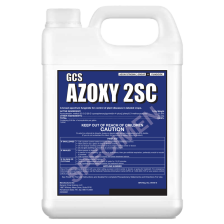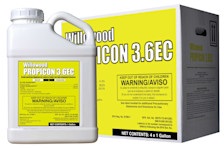Branded vs. Generic Crop Fungicides
With more fungicide active ingredients coming off patent in the coming years, you’ll soon have even more crop protection products to consider. Typically, patents expire 20 years after patent filing. That opens the door for other manufacturers to produce generic formulations that may be more affordable than the name-brand equivalent.
How do those generic products stack up?
Let’s look deeper at the main differences between generic and branded fungicides. In this post, we’ll answer:
Pros and Cons of Generic vs. Branded Fungicides
Generic Fungicides
Pros | Cons |
Lower price | Limited performance data |
No rebate programs, extra paperwork to manage | May have less effective inert ingredients |
More options/market competition | Generally limited field support |
Often equivalent performance as branded fungicides |
Branded Fungicides
Pros | Cons |
Proven performance with data validation | Higher price |
Backed by field support | May provide less value than generic products (performance vs. cost) |
May include more effective inert ingredients | May need to submit rebate paperwork to reduce product price |
Do Government Agencies Regulate Generic Fungicides?
Yes, generic fungicides are subject to the same rigorous registration process as the original branded products. This means that all the guidelines, restrictions, and reviews are comparable. From a regulatory standpoint, generic fungicides must contain the same active ingredient components as their branded counterparts to be registered by the government regulator.
Do Generic Fungicides Work as Well as Name-Brand Products?
One key advantage of generic fungicides is their potential to deliver similar results to their name-brand equivalents at a fraction of the cost. The generic version of a name-brand product contains the same active ingredient as the name-brand version, making the fungicidal activity very similar.
However, differences in the inert ingredients or product formulation, including the presence or absence of surfactants and adjuvants, may affect product penetration and plant uptake.
At FBN, we invest millions of dollars each year to conduct comprehensive analyses of our generic products to ensure they perform as well as or better than the branded product. Product evaluations include:
Laboratory screening (stability studies, physico-chemical testing like viscosity, pH, density, etc.)
Formulation testing (e.g., emulsion stability, persistent foaming, pourability, suspensibility, etc.)
Field trials comparing an FBN generic fungicide to its branded counterpart
Have a specific pest you need to manage? Check out our pest solution pages for recommendations.
Why Are Generic Fungicides Priced Lower Than Branded Products?
There are several reasons generic fungicides may be more affordable than brand-name products, including:
1. Minimal Investment Is Needed to Register a Generic Fungicide
Minimal investment is needed to register a generic fungicide because most of the heavy lifting has already been done by the original product manufacturer.
Many name-brand fungicides are manufactured by multinational companies that invest millions of dollars annually in the people, facilities, and research and development (R&D) required to bring new products to market. To counter those investments, they must extract the highest profit margin possible from their fungicide product.
Generic product producers can piggyback off the work that’s already been done to register these products to minimize costs.
2. Marketing Costs Are Less with a Generic Fungicide
Most generic fungicides don’t require extensive marketing because the name-brand product has been marketed and established among the agricultural community for decades. Branded products often charge a brand premium, extracting extra value for the recognition of their company and their product.
3. Formulation Chemistry May Cost Less
As previously mentioned, some inert ingredients in a generic product may differ from those in the brand-name product. Often, those inert raw ingredients may be less expensive, reducing the manufacturing cost of the generic product.
4. There Are No Middlemen to Share Profits With
Generic fungicide producers, including FBN, can cut out the intermediaries in the value chain, passing those savings on to farmers. For example, in early 2024, we announced the opening of our new blending facility within an existing FBN fulfillment center in Mississippi that allows us to offer a reliable supply of fairly priced ag chem and respond to product demand surges efficiently.
5. There Are Fewer Administrative Costs
Generic manufacturers typically do not have rebate programs and the associated administrative costs. Instead, they offer a lower up-front product cost, which is often more convenient for buyers.
Are Generic Fungicides Identical to the Branded Products?
The short answer is no. While generic fungicides typically have the same active ingredients as the brand-name equivalent, there may be slight formulation differences.
1. Differences in Inert Ingredients
Solvents, stabilizers, emulsifiers, surfactants, and other additives are part of a fungicide formulation but don’t have fungicidal activity as an active ingredient does. Instead, inert ingredients in the formulation may help enhance the spray application by:
Reducing product tie-up
Enhancing product uptake
Increasing dilution in water
Generic fungicides may have slightly different inert ingredients compared to brand-name products; however, product performance differences should be minimal unless one of the inert ingredients is missing.
2. Differences in Active Ingredient Concentration and Chemical Structure
While the active ingredient of a generic product must be the same as that of a name-brand equivalent, it may not be in the same concentration or have the same chemical structure. So, even though the chemical formula of two products is the same, the atoms in their molecular makeup may be positioned differently, leading to differences in biological activity.
For example, as M. Singh, W. Mersie, and R. H. Brlansky explored in “Phytotoxicity of the Fungicide Metalaxyl and Its Optical Isomers” for Plant Disease, the active ingredient of the systemic fungicide metalaxyl contains several chemical isomers, some of which are phytotoxic to young citrus trees.
Is a Generic Fungicide a Good Fit for Your Operation?
Generic fungicides can offer high-quality crop protection while reducing disease management input costs. To evaluate whether they are a good fit for your particular circumstance, compare their price, safety, and relative performance to the name-brand alternative. If performance data for the fungicide you’re interested in is unavailable, consider running a small in-field trial using name-brand and generic fungicides side-by-side to compare performance and mitigate risk.
As you evaluate generic products, compare their labels to the name-brand equivalents. Questions to ask as you compare the labels include:
Are the active ingredient concentrations the same?
Are the inert ingredients significantly different?
If so, do you anticipate performance differences?
Is the generic product labeled for the crops and application types you’re expecting to use it for?
FBN Generic Fungicide Alternatives
Learn more about some of the generic fungicide alternatives available through FBN.
Brand Name | Common Active Ingredient | FBN Product |
Bravo Weather Stik® | chlorothalonil | |
Aframe™ | azoxystrobin | |
Quilt Xcel® | azoxystrobin, propiconazole | |
Topsin® 4.5FL Fungicide | thiophanate-methyl | |
Onset™ 3.6L Fungicide | tebuconazole | |
TebuStar® 45WSP | tebuconazole | |
Tilt® | propiconazole |
Shop Fungicides from FBN
Choosing an effective fungicide can help protect your crop investment. Whether you prefer a generic or brand-name product, FBN has a portfolio of fungicides to help you manage crop diseases throughout the season. With 24/7 digital shopping access, direct-to-farm delivery, transparent pricing and savings opportunities, and detailed label information for each product, FBN offers the information and products you need to build an effective fungicide strategy this season.
Related Resources
Fungicides 101: Everything Farmers Need to Know About Fungicides
New FBN Blending Facility Strengthens Ag Chem Availability, Quality
© 2014 - 2025 Farmer's Business Network, Inc. All rights Reserved. The sprout logo, “Farmers Business Network”, “FBN”, "Farmers First", “FBN Direct” , "F2F", and "F2F Genetics Network" are trademarks or registered trademarks of Farmer's Business Network, Inc. All other trademarks are the property of their respective owners.
Aframe™ is a trademark of Syngenta.
Bravo Weather Stik® is a registered trademark of Makhteshim Agan Of North America, Inc.
Onset® 3.6L Fungicide is a registered trademark of Winfield Solutions, LLC.
Quilt Xcel® is a registered trademark of Syngenta Participations AG.
TebuStar® 45WSP is a registered trademark of Albaugh, LLC.
Tilt® is a registered trademark of Syngenta Participations AG.
Topsin® 4.5FL Fungicide is a registered trademark of Nippon Soda Company, Ltd.
FBN Direct products and services and other products distributed by FBN Direct are offered by FBN Inputs, LLC and are available only in states where FBN Inputs, LLC is licensed and where those products are registered for sale or use, if applicable. If applicable, please check with your local extension service to ensure registration status. Nothing contained on this page, including the prices listed should be construed as an offer for sale, or a sale of products. All products and prices are subject to change at any time and without notice and excludes CA mills tax and MN ACRRA fees. Terms and conditions apply.
ALWAYS READ AND FOLLOW LABEL DIRECTIONS. It is a violation of federal and state law to use any pesticide product other than in accordance with its label. The distribution, sale and use of an unregistered pesticide is a violation of federal and/or state law and is strictly prohibited. We do not guarantee the accuracy of any information provided on this page or which is provided by us in any form. It is your responsibility to confirm prior to purchase and use that a product is labeled for your specific purposes, including, but not limited to, your target crop or pest and its compatibility with other products in a tank mix and that the usage of a product is otherwise consistent with federal, state and local laws. We reserve the right to restrict sales on a geographic basis in our sole discretion. You must have a valid applicator license to use restricted use pesticides. Please consult your state department of agriculture for complete rules and regulations on the use of restricted use pesticides, as some products require specific record-keeping requirements.
All product suggestions and other information provided is for informational purposes only. It is not intended to be a substitute for consulting the product label or for specific agronomic, business,or professional advice. Where specific advice is necessary or appropriate, consult with a qualified advisor. Neither Farmer's Business Network Inc. nor any of its affiliates makes any representations or warranties, express or implied, as to the accuracy or completeness of the statements or any information contained in the material and any liability therefore is expressly disclaimed.





